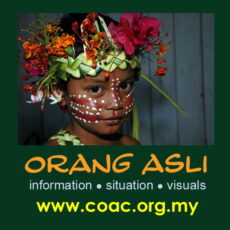PEOPLE FIRST
Orang Asli after 50 Years of Merdeka
Colin Nicholas
Published in Off The Edge, September 2007.
As the original peoples of the peninsula, the ancestors of the Orang Asli made footprints on this land for millennia. They were not a marginalised people then; they were autonomous peoples with full control of their society and over their traditional territory. Their support also helped establish the sultanates.
Ironically, when the country benefited from the decolonisation process 50 years ago, the Orang Asli began to experience what some now call ‘internal colonisation’. This is a process which involves paternalism, where one society governs the other in what it views as being the other’s best interest; and integration, where the people are subjected to the nation-state and expected to assimilate with the dominant national group.
Ironically also, in a country that accepts discrimination based on ethnicity and indigenousness as a given right, the Orang Asli do not enjoy commensurate recognition and encouragement of their cultures, languages, and spiritualities, let alone preferential treatment in their pursuit of economic advancement and educational opportunities. However, they are not demanding these as their inherent right; rather as the responsibility of a government towards its marginalised citizens.
Their unified, single-minded demand, nevertheless, is that their traditional territories be recognised as theirs. Thus far, the courts have accorded them such recognition. The authorities, however, still choose to deny the Orang Asli this fundamental right, thereby allowing the remaining lands of the Orang Asli to be slowly whittled away.
Some of the lands that were approved for gazetting as Orang Asli Reserves as far back as the Sixties were never administratively gazetted. In fact, some of these areas have now been reclassified as state land or Malay Reserve Land, or have been given to individuals and corporations – without the Orang Asli’s knowledge, let alone consent.
And while it is being bandied about that the proposed Orang Asli Land Policy will address the Orang Asli land problem by setting aside some 75,900 hectares for 30,000 Orang Asli families, the reality is that the Orang Asli will stand to lose 51,798 hectares (40 per cent) of the 127,698 hectares that the government already recognises in 2003 as Orang Asli lands.
Furthermore, these 6.25 acre (2.53 hectares) family plots are assigned to them on a 99-year-lease basis. Nothing can be more graphic of the Orang Asli’s fate – that their inalienable right to their land now has an expiry date.
It used to be that it was the Orang Asli’s lands (and, to a certain extent, their souls as well) that were coveted. But now, it is becoming clear that even the Orang Asli’s cultural heritage is being targeted to bring in the tourist ringgit or to shore up someone’s image.
The Orang Asli ‘sewang’ is now declared one of the 50 national heritage treasures. It enjoys the unique position as the only national heritage treasure to supposedly encompass all the 18 Orang Asli ethnic groups, and all their ‘ceremonies or rituals ranging from weddings, births and welcoming ceremonies to rituals for healing, burial and warding off evil spirits’. Somebody has obviously not done his homework here, or the Orang Asli were not consulted.
On the contrary, the sewang as defined and performed by the (non-Orang Asli) dancers at the recent Citrawarna 2007 and other events for this Visit Malaysia Year reflects ignorance of the true Orang Asli cultural heritage and, perhaps, even scorn.
Imagine men and women jumping around in unrecognisable costumes and dance steps to music accompanied by vocals that are nothing but guttural sounds. The masks that were worn seemed to be copied from some Japanese opera coffee-table book. They’ve certainly got it wrong. Unless of course, the aim is to commercialise and aggrandise the sewang, as was done during the World Rainforest Music Festival in Sarawak: the Mah Meri dance routine (which did not include a ‘sewang’) was choreographed to include a wedding ceremony, which is never a part of the dance. Why? For whom?
But perhaps the biggest attempted usurpation of Orang Asli heritage this year was the instruction to the Mah Meri of Kampung Bumbun in Pulau Carey to have their Hari Moyang (Ancestors’ Day) ceremony on a national level, on a date set by a ministry committee that suited the Visit Malaysia Year calendar. However, this date was a fortnight earlier than that set by the elders in accordance with their traditions. It would have been akin to celebrating Hari Raya in the middle of the puasa month.
To the credit of the Mah Meri, they stood their ground and the ministry was forced to rename the event ‘Pesta Seni Orang Asli Semenanjung Malaysia’ (Peninsular Malaysia Orang Asli Cultural Festival) just days before the event.
All these make it appear that in the daze to promote Malaysia as a hub of diverse cultural heritage, that of the Orang Asli is being perceived, manufactured and packaged as if it were some commodity meant for revenue-generation.
Notwithstanding all the above, it must be said that there have been marked improvements in the lives of the Orang Asli since 50 years ago, even if these compare poorly with the rate of progress achieved by the others.
So this year is an opportunity to reflect on the course the country has taken the past five decades, and where it is taking its marginalized first peoples. It is certainly time to sit down, listen and give back.

